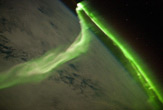Northern Lights Get Internet Reality Show

This story was updated at 12:45 p.m. ET.
Aching to see the dazzling aurora displays that make up the northern lights, but can't get to the Arctic Circle to see them? Don't worry, a new Internet show has you covered.
The new web-based observatory AuroraMAX will go live tonight (Sept. 20) to broadcast real-time views of eye-catching northern lights, called the aurora borealis, as part of an outreach project by the Canadian Space Agency. [Amazing Aurora Photos]
"Armchair skywatchers everywhere can now discover the wonder of the northern lights live on their home computer screen," space agency chief Steve MacLean said in an announcement. "We hope that watching the dance of the northern lights will make you curious about the science of the sky and the relationship we have with our own star, the sun."
The Canadian Space Agency teamed up with the University of Calgary, the skywatching publication Astronomy North and the city of Yellowknife, which is about 318 miles (512 km) south of the Arctic Circle. According to the city's website, Yellowknife is "known for our outdoor recreation, midnight sun, aurora borealis and an unusual blend of northern culture."
The AuroraMAX website will include tips on how to observe auroras, explanations on why they occur, and highlight Canadian research into the relationship between the sun and Earth that leads to the dazzling sky shows. Photo galleries and videos of the phenomenon will also be included. A recap of each night will be broadcast on the following day.
Auroras occur when charged particles from the sun are funneled toward Earth by the planet's magnetic field and collide with the upper atmosphere near the poles. They are more active when the sun's activity peaks during its 11-year solar weather cycle. The sun is currently entering an active phase of its present cycle, so astronomers expect the northern lights to be more common and more dazzling over the next couple of years.
Sign up for the Live Science daily newsletter now
Get the world’s most fascinating discoveries delivered straight to your inbox.
In addition to the aurora borealis in the north, the South Pole region also sees its own aurora displays, called the aurora australis.
In Canada, the peak of the aurora season typically runs from late August to May, because the nights are longer. The auroras themselves occur all year.
"The reason we classify August through May as the 'aurora watch' season is because of the extended number of 'dark' hours in Canada," aurora researcher Emma Spanswick of the University of Calgary told SPACE.com in an e-mail. "From an instrumentation perspective, the cameras we use to observe the aurora (like the AuroraMAX camera) are very sensitive. They are only able to operate when the sun is at least 12 degrees below the horizon … and in Northern Canada, that only happens between the months of August and May."
The AuroraMAX observatory will broadcast views of the northern lights through the sun's peak activity period, called solar maximum, which is expected in 2013, researchers said.
- Gallery — Amazing Aurora Photos of 2010, Solar Storms
- Video — How Space Storms Wreak Havoc on Earth
- A Guide for Watching Earth's Auroras
To see the AuroraMAX broadcasts, visit: http://www.asc-csa.gc.ca/auroramax











